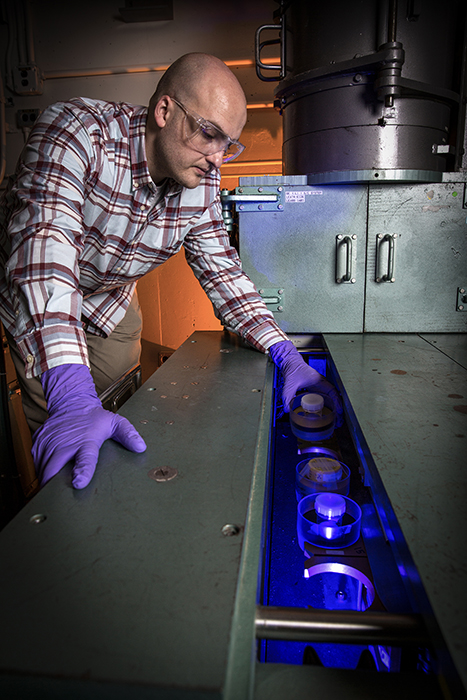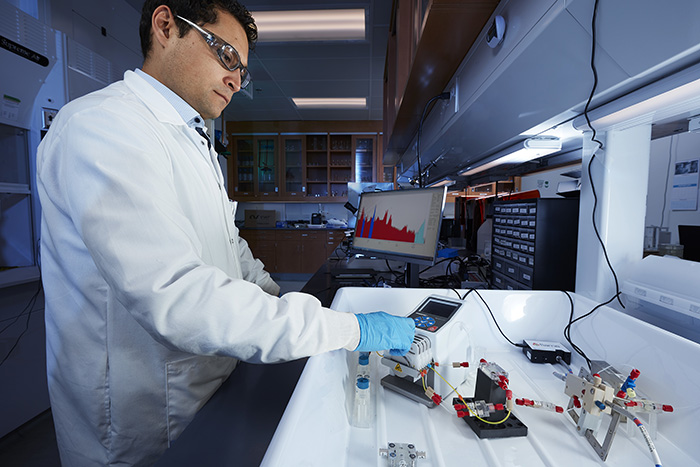LLNL scientists perform fundamental and applied research in nuclear science, and they develop advanced experimental methods that expand the scope of their explorations.
Nuclear science at the National Ignition Facility
Scientists leverage experimental capabilities at LLNL’s National Ignition Facility (NIF) to study the effect of plasmas on nuclear reactions. NIF is the brightest neutron source in the world, and this novel capability enables researchers to produce nuclear reactions involving materials that are relevant to the Lab’s national security mission. This environment also makes it possible for them to study the effects of plasma environments on nuclear reaction rates.
They also explore ways to enhance experimental capabilities in this research space. For example, they developed a technique to dope target capsules with very small quantities of elements. A robotic micro-injection system automatically aligns a microcapillary with a fill-tube hole, for injection into the millimeter-sized target capsules.
In addition to nuclear forensics applications, astrophysicists are interested in these types of reactions because of NIF’s ability to duplicate conditions at the interior of stars. By studying nuclear reactions within the star-like plasmas generated by NIF, researchers can explore nuclear synthesis, the stellar process that eventually creates heavier elements by fusing together lighter elements and particles. This capability also allows scientists to measure stellar nuclear reaction rates on Earth, as the interior of NIF capsules reaches temperatures and pressures that closely mimic the conditions found inside stellar interiors.
Nuclear cross sections
An isotope’s neutron-capture cross section—the likelihood that a nucleus will absorb a neutron—is important to many scientific processes, such as the forging of elements in the cosmos, as well as nuclear science applications spanning reactor performance, nuclear medicine, and stockpile stewardship. Although cross sections have been established for most stable nuclei, almost no data exists for radioactive isotopes. Recently, LLNL scientists explored the nuclear cross-section for zirconium-88, an important radiochemical diagnostic for nuclear security applications. They determined that its thermal neutron capture cross-section is five orders of magnitude larger than the theoretically predicted value.
LLNL scientists collaborate with academic partners to conduct cross-section measurements of radioactive isotopes, using world-class accelerator facilities, including the Facility for Rare Isotope Beams at Michigan State University—a U.S. Department of Energy user facility. As experimental capabilities expand, research teams will continue exploring the mysteries of neutron-rich nuclei near the limits of stability.
Rapid separation chemistry
LLNL scientists explore ways to enhance chemical separation processes, offering faster analytical capabilities and more selective extraction techniques. For example, they developed a microfluidic platform that uses a porous membrane to selectively filter tiny samples using a chemical extractant, separating the elements of interest from the rest of the sample. The separation process takes less than 30 minutes. Investigators then quantify each element’s mass and isotopic ratios using nuclear and optical spectrometric techniques to determine the sample’s characteristics.
The chemical separation process can be tailored for analytical measurements of a variety of actinides, enabling LLNL’s radiochemists to isolate subtle actinide signatures. This type of automated, rapid separation chemistry can also be applied to isotope harvesting, where isotopes produced as byproducts in accelerator irradiations are collected and used in radiochemistry experiments.
Learn more about nuclear science research at LLNL
Nuclear astrophysics at the National Ignition Facility
Accelerating Nuclear Forensics in the Field, Science & Technology Review magazine, January 2022
A Revelation in Nuclear Science, Science & Technology Review magazine, July 2020
Stellar reactions in a galaxy not so far, far away, LLNL news, July 2019
Providing data for nuclear detectives, LLNL news, March 2015






